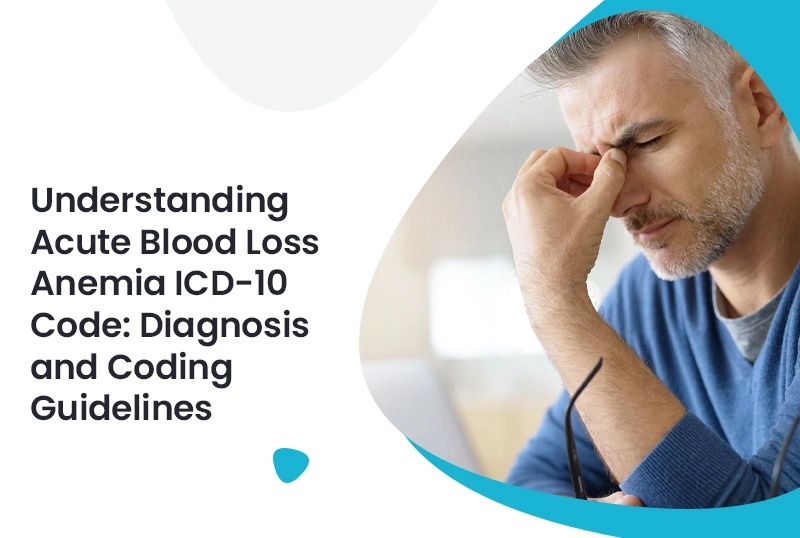When dealing with sudden blood loss anemia, it is very important to get the diagnosis and codes right. Understanding the ICD-10 code for acute blood loss anemia is important for healthcare workers and billing staff. This ensures accurate records and timely payments. A medical billing company can help practices figure out how to code correctly so they don’t make mistakes that could cause claims to be denied.
Acute blood loss anemia must be treated promptly and coded accurately, whether from injury, surgery, or stomach bleeding. Let’s go over the most important parts of this condition and how to correctly code it using the ICD-10 method.
What is Acute Blood Loss Anemia?
Acute blood loss anemia occurs when a patient loses a significant amount of blood quickly, resulting in a reduced number of red blood cells and oxygen-carrying capacity. This condition can develop due to various causes, such as:
- Trauma or injury
- Surgical procedures
- Gastrointestinal bleeding (e.g., ulcers, varices)
- Internal bleeding (e.g., ruptured aneurysms)
The ICD-10 code for acute blood loss anemia is D50.0. It is used when anemia develops as a result of a rapid loss of blood, leading to decreased oxygen levels in the body.
Common Causes of Acute Blood Loss Anemia:
- Trauma: Severe injuries that cause rapid blood loss.
- Surgical procedures: Blood loss during or after surgery.
- Gastrointestinal bleeding: Conditions like ulcers or diverticulosis.
- Hemorrhages: Internal bleeding due to ruptures or tears in blood vessels.
Proper diagnosis is key to distinguishing acute blood loss anemia from other types of anemia, such as chronic anemia or anemia due to nutritional deficiencies.
ICD-10 Code for Acute Blood Loss Anemia: D50.0
The ICD-10 code D50.0 is specifically used to identify acute blood loss anemia. When coding for this condition, it is essential to include:
- A detailed medical history explaining the cause of blood loss.
- Lab results show low hemoglobin and hematocrit levels, which are indicative of anemia.
- Medical interventions, like transfusions or surgical procedures to stop the bleeding.
How to Code Acute Blood Loss Anemia:
- D50.0 is used when the anemia is caused by significant blood loss.
- When blood loss is secondary to another condition, ensure both conditions are documented and coded correctly.
- Accurate documentation helps medical billing and coding specialists ensure that the correct codes are applied, reducing the risk of a denied claim.
Read more about: D50.9 Explained: How to Code Iron Deficiency Anemia the Right Way
The Role of Revenue Management in Blood Loss Anemia Coding
When it comes to acute blood loss anemia, correct coding plays a crucial role in a healthcare facility’s revenue cycle. Revenue Cycle Management (RCM) ensures that the coding process is efficient and that claims are processed smoothly.
How Improves Coding:
- Accurate Diagnosis: Properly documenting acute blood loss anemia ensures that claims are submitted with the correct codes, reducing the chances of errors.
- Timely Reimbursement: Efficient coding practices lead to quicker claims processing, meaning healthcare providers get paid faster for the services rendered.
- Claim Denial Prevention: Working with experienced RCM professionals can help prevent common coding mistakes that may lead to claim denials.
Efficient revenue cycle management ensures that healthcare providers spend less time on administrative tasks and more time focusing on patient care.
Common Challenges in Coding Acute Blood Loss Anemia
While coding for acute blood loss anemia, ICD-10 is straightforward; several challenges can arise:
- Lack of detailed documentation: Without a comprehensive patient history, healthcare providers may struggle to assign the correct code, leading to potential rejections.
- Secondary conditions: If the anemia is caused by another underlying condition (e.g., gastrointestinal bleeding), both conditions must be documented and coded correctly.
- Coding ambiguities: ICD-10 codes are often specific, so it’s important to select the most appropriate code based on the type and cause of anemia.
Working with a skilled medical billing company can significantly reduce these challenges by ensuring that all codes are applied correctly, avoiding costly errors.
The Importance of Accurate Billing and Coding
Accurate medical billing and coding is essential for ensuring that healthcare providers receive appropriate reimbursement for their services. Errors in coding can lead to claim denials, delayed payments, or even audits. For acute blood loss anemia, applying the correct ICD-10 code is crucial in reflecting the severity and cause of the condition.
- Faster Claims Processing: Correct coding helps speed up the claims process and reduces the chances of claim delays.
- Reduced Claim Denials: With accurate coding, you’re less likely to face rejections or audits.
- Improved Cash Flow: Accurate medical billing and coding help ensure that the practice is paid in full and on time for the services rendered.
Both healthcare providers and billing professionals must work closely to ensure that all aspects of the patient’s condition are documented and coded accurately.
Conclusion
Both medical workers and revenue cycle management services teams need to understand ICD-10 codes. By using the correct diagnosis codes and ensuring the right documentation, healthcare workers can speed up their billing process, avoid denials, and improve cash flow. Effective medical billing and coding not only benefit healthcare organizations but also ensure that patients receive the timely and accurate care they need.
FAQs
1. What is the ICD-10 code for acute blood loss anemia?
The ICD-10 code for acute blood loss anemia is D50.0.
2. How do I know if I should use the unspecified code for acute blood loss anemia?
Use the unspecified code when the exact cause of blood loss is unclear or not documented in the patient’s records.
3. How can revenue cycle management help in coding?
Revenue cycle management ensures accurate and timely coding, reducing denials and improving the reimbursement process for healthcare providers.
4. What are the common causes of acute blood loss anemia?
Common causes include trauma, gastrointestinal bleeding, surgery, or internal hemorrhages.







